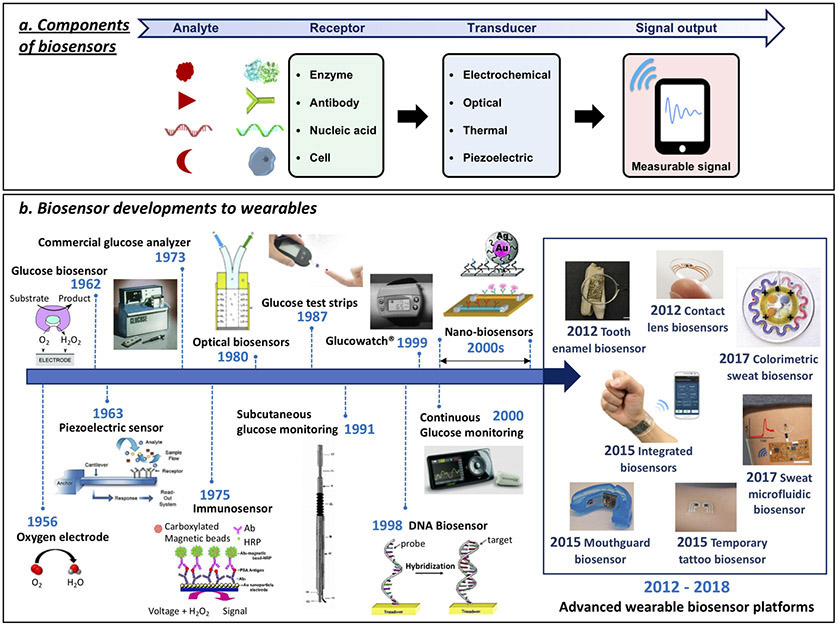Figure 1.
Biosensor components and the path of biosensor development for wearables. (a) Schematic representation of biosensor operation principles: Target analyte detection by corresponding receptor molecule followed by signal transduction method and output. (b) The concept of enzyme electrodes was proposed by Clark and Lyons in 19627. Their device relied on entrapment of the enzyme glucose oxidase (GOx) over an amperometric oxygen electrode that monitored the oxygen consumed by the biocatalytic reaction. Clark’s electrochemical biosensor technology was transferred to the Yellow Spring Instrument (YSI) Company, which launched the first dedicated blood glucose analyzer (YSI Model 23 Analyzer) in 1975. Biosensors became a ‘hot’ topic during the 1980s, reflecting the growing emphasis on biotech. New biosensor transduction principles were introduced during this decade, including fiber-optic and mass-sensitive (piezoelectric) devices8-14. Considerable efforts during the 1980s led also to the introduction of commercial self-testing blood glucose strips that used mediator-based enzyme electrodes15,16. Subsequent activity during the 1990s resulted in subcutaneously implantable needle-type electrodes for real-time in vivo glucose monitoring17. These subcutaneously implantable glucose sensors moved in the early 2000 to commercial continuous glucose monitors (CGMs) that track in real-time the glucose level in the ISF, along with diabetes relevant trends and patterns18,19. The emergence of nanotechnology in the late 1990s has led to variety of nanomaterial-based biosensors exploiting the attractive properties of different nanomaterials, such as silicon nanowires and gold nanoparticles, for label-free or amplified biosensing, respectively20,21. The specific base-pair recognition of DNA sequences led to the development of different DNA biosensors in the late 1990s22-24. Such nucleic acid sensors are currently playing a growing role in genomic sequence analysis. These advances in biosensor technology over the past five decades paved the way to modern wearable biosensors, discussed in this article. (Glucose biosensor adapted from J.W. et al.25). Piezoelectric sensor adapted from ref. 26. Commercial Glucose Analyzer adapted from ref. 27. Immunosensor adapted from ref. 28. Optical Biosensor adapted from ref. 10. Glucose test strips adapted from ref. 29. Subcutaneous glucose monitoring adapted from ref. 17. GlucoWatch adapted from ref. 30. DNA Biosensor adapted from ref. 24. Continuous glucose monitoring adapted from ref. 31. Top nanobiosensors adapted from ref. 21. Bottom nanobiosensors adapted from ref. 20. Tooth enamel biosensor adapted from ref. 32. Contact lens sensors adapted from ref.33. Colorimetric sweat biosensor adapted from ref. 34. Integrated biosensors adapted from ref. 35. Mouthguard biosensor adapted from (J.K., J.W et al.)36. Temporary tattoo biosensor adapted from J.W. and colleagues37. Sweat microfluidic sensor adapted from (J.K., A.S.C., J.W. et al.)38.

